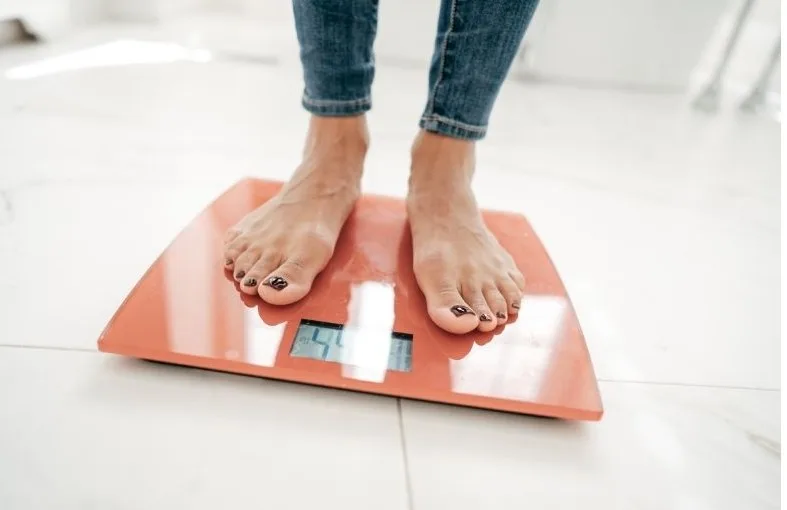Some of the links in this post are affiliate links. This means if you click on the link and purchase the item, we will receive an affiliate commission from the vendor at no extra cost to you. These business relationships allow us to keep bringing you great EatMoveHack content. All opinions remain our own.
Whether you’re shedding a few pounds or tackling a larger weight loss goal, having a plan to jumpstart weight loss is important. The first step is often the hardest—knowing where to begin and creating a sustainable plan to stay on track.
We’re here to guide you with tools and tips to kick-start your journey. While we can’t promise instant results (because safe, lasting weight loss takes time), we can show you how to make meaningful changes that work.
Start Smart, See Results
Jumpstarting weight loss doesn’t require drastic measures. Begin with small, realistic adjustments like increasing whole foods in your diet, staying hydrated, and committing to consistent physical activity. Simple habits like these can make a noticeable difference in your energy, mood, and weight within weeks.
Consistency is key, so focus on creating routines you can maintain long-term. These foundational changes will help you see faster progress without sacrificing your health.
Your Journey to Wellness
We’re passionate about helping you feel and look your best. With the steps outlined in our tutorial, you can take control of your weight loss journey. Start today, and in just a couple of weeks, you’ll see how small, smart changes can lead to big results.
At a glance
- Time to complete project: 4 hours
- Project difficulty out of 5: 2 out of 5
Supplies list
- Calorie-tracking fitness app
- BMI and TDEE calculators
- Food scale
- Water bottle
Instructions: How to Jump-Start Weight Loss Safely and Effectively
To lose weight, you have to know where you’re beginning, where you’re heading, and how you’re going to get there. Our tutorial will guide you through setting goals and tracking your progress, but it also offers easy tips for making the journey a little bit easier.
Warning! Making lots of lifestyle changes at the same time can be difficult. If you’re feeling overwhelmed following our guide, don’t hesitate to spread out our suggestions over several days or weeks. It’s much to move slowly than to give up before you’ve even started.
1. Set Realistic Weight Loss Goals
If your previous weight loss efforts haven’t quite panned out, it could be because you haven’t set out clear goals and expectations. Obviously you want to lose weight, but how are you going to do it? As in, what are the exact steps you’re going to take?

Many diets fail because people skip the very important first step of creating an action plan. You have to determine where you are, where you’re going, and how you’re going to get there.
To put it another way: What is your current caloric intake, what is your goal weight, and what kind of caloric deficit do you need to get from point A to point B?
Here are the steps you need to complete to figure it all out:
- To determine how much you’re currently eating, download a fitness app that tracks calories and record everything you put in your mouth for two weeks. By the end of the two-week period, you can figure out your daily average caloric intake.
- To decide on a goal weight, talk to your doctor or consult body mass index (BMI) charts to determine an appropriate range for your height, age, and gender. Keep in mind that your goal weight doesn’t need to be set in stone; you can adjust it as needed or even set several goals.
- Once you know how many calories you’re currently eating and how much weight you’d like to lose, use a total daily energy expenditure (TDEE) calculator to figure out an appropriate and realistic calorie deficit. Depending on how many calories you burn, a deficit of 500 calories per day might be safe; stick with it, and you could lose one pound per week.
2. Create a Shopping List
What you eat is just as important as how much you eat when it comes to jumpstarting weight loss. Making smarter food choices offers two big benefits: you’ll nourish your body with essential nutrients and enjoy meals throughout the day without worrying about overloading on calories.
Plan Ahead with a Shopping List
Before heading to the supermarket, write a shopping list—and stick to it. A list keeps you focused, helps you shop more efficiently, and minimizes the temptation to grab calorie-heavy, processed foods.
Fill Your Cart with Whole, Nutrient-Dense Foods
Prioritize fresh fruits and vegetables. These whole, unprocessed foods are low in calories but rich in vitamins and nutrients, making them essential for weight loss.
When it comes to protein, choose lean options like chicken, turkey, and fish. Other excellent sources include eggs, beans, Greek yogurt, cottage cheese, tofu, and peanut butter. These foods keep you full longer and fuel your body for the day ahead.
Limit Starches and Avoid Processed Foods
Even if you’re not following a low-carb diet, limit calorie-dense starchy foods like bread, pasta, and rice. These burn off quickly and don’t sustain you as well as whole, fiber-rich alternatives. Avoid prepackaged convenience items, which often lack nutrition and are loaded with unnecessary calories.
By planning your meals and focusing on whole, nutrient-dense foods, you’ll support your weight loss goals while nourishing your body.
Even those that may seem healthy, like a protein bar or chips made from vegetables, are actually fake health foods that are often packed with high amounts of sugar and fat, meaning more calories.
3. Track Your Calories
Hopefully it’s very apparent by now that calories are a big deal. They are one of the most important measures of food, especially when you’re losing weight, and they must be tracked carefully to ensure you stay on track.
To ensure accurate recordings, it’s vital that you invest in a food scale. Most people are awful at estimating portion sizes, so if you try to eye your calorie count, you’ll almost certainly consume more calories than you’re supposed to.
On top of that, even product labels can be deceiving or just plain wrong. It’s not uncommon to find product labels that may claim a slice of bread is 25 grams or a cup of ice cream is 150 grams, only to see the truth once you weigh the food on a scale. If you blindly follow the food label and your bread turns out to weigh 50 grams, you’ll consume twice the calories intended.
In addition to a food scale, continue to use the fitness app from step 1. Using a digital calorie counter is so much easier and more convenient than tracking your calories by hand.
4. Invest in a Water Bottle
Drinking more water has lots of benefits. For starters, it has no calories, so you can drink as much as you’d like without worrying about whether it’s going to negatively impact your waistline.

In terms of weight loss, it can help you stave off hunger by filling your stomach. For the same reason, it can also make you feel fuller during meals. Other benefits include increased energy, better alertness, and improved digestion.
Drinking water throughout the day is one of the most healthy habits you can establish, but it can be difficult to get started if you’ve always reached for soda or just went without.
An easy way to incorporate H20 into your schedule is to invest in a water bottle. Fill it in the morning and keep it nearby, and you’ll find that you naturally reach for it just because it’s there.
If you find plain water boring, you can spice things up by adding flavorful mix-ins like mint, cucumber, and sliced fruit. Sugar-free drink mixes are also an option, but be sure to read product labels to be sure they really are zero-calorie.
5. Find Ways to be More Active
While diet plays a bigger role in weight loss, exercise is a valuable tool for jumpstarting weight loss and improving overall well-being. Staying active not only burns calories but also keeps your heart healthy, reduces stress, and improves sleep. These benefits help you feel better, keeping you motivated to stick with healthy habits.
Easy Ways to Get Started
If you’re new to exercise, don’t worry! You don’t need fancy equipment or long workouts to see results. Start small with short, manageable exercises that won’t leave you sore the next day.
A great strategy is to incorporate movement into your daily routine. Try jogging in place during TV commercials, doing squats while loading the dryer, or squeezing in jumping jacks while waiting for the microwave. These quick bursts of activity add up, making it easier to stay consistent.
The Key Is Consistency
Regular exercise not only supports weight loss but also improves your mood, energy levels, and sleep quality. By finding small, simple ways to stay active, you’ll feel better and more motivated to maintain your healthy habits over time.
Remember, every little bit counts. Use these easy tips to add exercise into your day and jumpstart your weight loss journey.
If you want to take exercise more seriously, consider buying a little bit of equipment. New shoes or workout wear can motivate you to hit the pavement or the gym. Hand weights and a jump rope are compact and affordable, allowing you to take your exercise anywhere you’d like.
As far as what exercise to do, it’s up to you. Cardio exercises like running or aerobics burns calories and increases your stamina, but if you’re looking to build lean muscle, you’ll want to turn to weight training.
You can stick with the same exercise every day if you’d like, or you can mix up your workout by alternating between cardio and strength training. Creating a solid exercise plan isn’t too important at this stage; just do what you need to do to move more.
6. Distinguish Hunger from Boredom
Hunger pangs can be a real problem when you’re trying to lose weight. You’re most likely to experience them if you greatly reduce your calorie intake or go too long between meals.
There’s also the issue of confusing boredom or stress with hunger. Feeling as if you have to eat when you’re bored or under pressure is known as emotional hunger, and it’s purely psychological. Eating when you’re emotional releases dopamine that makes you feel “full”, but your body doesn’t actually need the food.
Combating emotional eating isn’t easy, especially if it’s been a long-time coping mechanism. However, one way you can try to break the habit is to question yourself every time you feel hungry — are you really hungry, or are you reaching for food out of habit or comfort?
If you’re unsure of the answer, try doing something else for a little while. Call a friend to chat, read a book outdoors, or take a walk. These activities can increase dopamine levels just like eating does, relieving your craving. If you’re still feeling peckish after, reach for a small, healthy snack.
7. Stay Positive
As difficult as it may be to hear, you’re likely to hit roadblocks as you work to lose weight. There may be days when you don’t eat as well as you should and days when you feel like giving up completely.
This is all natural, because losing weight isn’t a chore that you can cross off a list; it’s a process, and sometimes, it’s a long and complicated one.
For this reason, it’s important to maintain a positive outlook. Consider keeping a journal where you track your milestones and celebrate your successes. Create new goals as you meet old ones so you stay engaged; they can be as general as “eat more fruits” or as specific as “switch to whole wheat bread”.
And if you feel as if you need help sticking with your new daily routine, don’t hesitate to find someone to connect with. Look for support at the gym, or join an online community of people who are working towards the same goals as yourself.

